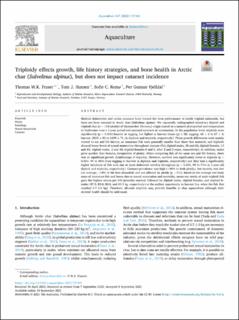| dc.description.abstract | Skeletal deformities and ocular cataracts have limited the farm performance of sterile triploid salmonids, but have not been assessed in Arctic char (Salvelinus alpinus). We repeatedly radiographed mixed-sex diploid and triploid char (n = 110/ploidy) of Hammerfest (Norway) origin reared on a natural photoperiod and temperature in freshwater over a 3-year period and assessed cataracts at termination. At the population level, triploids were significantly (p < 0.001) heavier at tagging, but lighter at harvest (mass (g) ± SE; tagging, 48 ± 2 vs 67 ± 3; harvest, 2015 ± 83 vs 1639 ± 71, in diploids and triploids, respectively). These growth differences were mainly related to sex and life history, as immature fish were generally smaller than those that matured, and triploids showed lower levels of sexual maturation throughout (mature (%); diploid males, 20 and 65; diploid females, 12 and 83; triploid males, 2 and 40; triploid females 0 and 0, after 2 and 3 years, respectively). In addition, males grew quicker than females, irrespective of ploidy. When comparing fish of the same sex and life history, there was no significant growth disadvantage of triploidy. However, survival was significantly lower in triploids (p < 0.001: 94 vs 86% from tagging to harvest in diploids and triploids, respectively) and they had a significantly higher incidence of fish with one or more deformed vertebra throughout (p < 0.001, 99 vs 71% in 3 year-old diploid and triploids, respectively). Cataract prevalence was high (>90% in both ploidy), but severity was low (on average, <10% of the lens shrouded) and not affected by ploidy (p > 0.1). Based on the average wet body mass of immature fish and losses due to sexual maturation and mortality, mono-sex stocks of male triploid fish gave the highest return per 100 juveniles stocked, followed by diploid males, diploid females, and triploid females (87.5, 83.0, 80.8, and 69.3 kg, respectively) at the earliest opportunity to harvest (i.e. when the fish first reached 0.7–1.0 kg). Therefore, all-male triploids may provide benefits to char aquaculture although their skeletal health should be addressed. | en_US |
